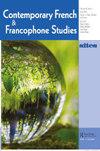媒体对杜拉克《香烟》的影响
IF 0.2
4区 文学
0 LITERATURE, ROMANCE
引用次数: 0
摘要
法国青年杰梅纳·杜拉克以感性和创新,揭示了资产阶级关系的缺陷。她现存最早的电影《香烟》(1919)揭示了丈夫自杀后婚姻所滋生的自卑。执着于“理想”的父权婚姻,当妻子拒绝呆在家里时,丈夫陷入绝望。他的痴迷反映了萨拉·艾哈迈德的观点,即幸福是一种社会义务,而不是一种真诚的感觉(《幸福的承诺》,2010)。在叙事之外,杜拉克的创作过程与马歇尔·麦克卢汉对社会技术气候对心理影响的分析是相吻合的。杜拉克的目标是改变麦克卢汉在《媒介是按摩》(the Medium is the Massage, 41)中分析的“独特的感官知觉比例”,她利用了所有可用的技术,取得了成功。在《La Cigarette》中,彩色滤光片、虹膜镜头和排版的变化打破了幸福婚姻和妻子作为客体的规范。这种干扰在女性身体与音乐接触时最为明显。听觉与视觉语言文本一起体现了我所说的“媒体影响”,或者是Dulac优化她的媒体所产生的情感反应。这种对《香烟》的解读综合了感知媒介理论(麦克卢汉)、情感客体(艾哈迈德)以及对杜拉克电影摄影的现有研究。本文章由计算机程序翻译,如有差异,请以英文原文为准。
Media Affects in Dulac’s La Cigarette
Abstract With sensuality and innovation, French cinéaste Germaine Dulac illuminated the flaws in bourgeoise relationships. Her earliest extant film La Cigarette (1919) exposes the self-contempt that marriage breeds as it follows a husband’s suicidal mission. Fixated on living an “ideal,” patriarchal marriage, the husband falls into despair when his wife refuses to stay at home. His obsession reflects Sara Ahmed’s notion of happiness as a social obligation rather than a sincere feeling (The Promise of Happiness 2010). Beyond the diegesis, Dulac’s creative process and Marshall McLuhan’s analysis of the socio-technical climate’s influence on the psyche dovetail. Dulac aimed to transform the “unique ratios of sense perception” that McLuhan analyzes in The Medium is the Massage (41), and she succeeded by deploying all the technology at her disposal. In La Cigarette, color filters, iris lenses, and typographical variations collapse the happy marriage and wife-as-object norms. This disruption occurs most notably as the female body engages with music. Aurality along with visual-verbal texts exemplify what I am calling “media affects,” or the affective responses that emerge from Dulac optimizing her medium. This reading of La Cigarette synthesizes a media theory of perception (McLuhan), the affective object (Ahmed), and existing research on Dulac’s cinematography.
求助全文
通过发布文献求助,成功后即可免费获取论文全文。
去求助
来源期刊

Contemporary French and Francophone Studies
LITERATURE, ROMANCE-
CiteScore
0.30
自引率
0.00%
发文量
43
期刊介绍:
An established journal of reference inviting all critical approaches on the latest debates and issues in the field, Contemporary French & Francophone Studies (formerly known as SITES) provides a forum not only for academics, but for novelists, poets, artists, journalists, and filmmakers as well. In addition to its focus on French and Francophone studies, one of the journal"s primary objectives is to reflect the interdisciplinary direction taken by the field and by the humanities and the arts in general. CF&FS is published five times per year, with four issues devoted to particular themes, and a fifth issue, “The Open Issue” welcoming non-thematic contributions.
 求助内容:
求助内容: 应助结果提醒方式:
应助结果提醒方式:


